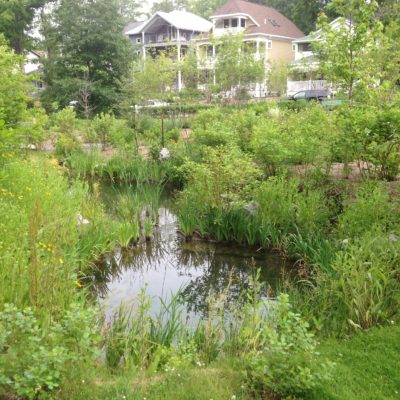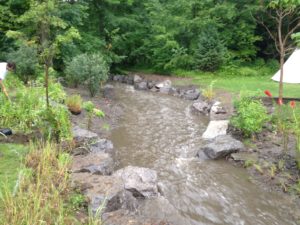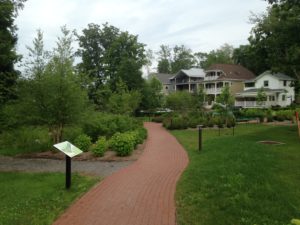
The Chautauqua Institution had a problem. Algae in Chautauqua Lake had reached unsafe levels. The algae blooms, caused by an overabundance of phosphorus in the water, were not just unattractive: they were toxic to swimmers and wildlife as well.
Founded in 1874, the Chautauqua Institution’s resort and adult education center had long been renowned for its natural splendor. Algal blooms were not part of the plan. So the Chautauqua Institution contacted Wendel with a simple request: implement a green infrastructure plan to improve water quality.
The project, which took place from 2013 to 2015, was a success. Through green infrastructure, Wendel helped to improve water quality while enhancing the beauty of the landscape.
Why green infrastructure?
The term “green infrastructure” encompasses a wide range of tools and techniques designed to balance human infrastructure needs with the impact they have on the natural environment. The basic thinking is to design with nature, not against it. That is exactly what Wendel did at the Chautauqua Institution.
Stormwater contributes to the water quality problems in Chautauqua Lake. When it rained, stormwater picked up phosphorous from streambanks, roadways and other sources, and washed it into Chautauqua Lake, feeding the algae.
In a traditional infrastructure project, this type of problem is addressed by diverting flow to buried treatment boxes. This typically results in an expensive, difficult-to-maintain infrastructure project, a disrupted environment, and several manholes placed throughout the landscape.
With green infrastructure, the goal is to keep as much of this water out of the sewer system as possible. The project team worked to naturally filter the water with plant life, slowing down flows and directing stormwater through constructed landscape features. The outcome was an infrastructure that was effective, easier to maintain, and complementary to the Chautauqua Institution’s natural beauty.
Our Plan at Chautauqua
For the green infrastructure project with the Chautauqua Institution, there were three major requirements:
- High impact on water quality. The top priority was improving water quality to make the water safe again.
- High visibility. By working in highly visible sites on the Chautauqua Institution’s campus, Wendel found ways to educate the public on green infrastructure and the local ecosystem.
- High returns for Chautauqua Institution. Wendel aimed to improve not only the Chautauqua Institution’s infrastructure, but the experiences of their visitors as well.
With these requirements in mind, the project team designed a project with three major components: a bioswale, streambank stabilization and constructed wetland.
The Bioswale: Slowing the Flow
In simple terms, a bioswale is a planted ditch. The bioswale built at the Chautauqua Institution was filled with plants chosen to filter phosphorous out of stormwater.
Plants need phosphorous, which is why green infrastructure was such a great solution for the Chautauqua Institution. Using the bioswale, the project team could divert phosphorous-rich water to the plants that needed it to grow, thereby starving the algae in the lake. The challenge was slowing the flow of water. If the water flow was too rapid, it would rip out all the plants in the bioswale and nothing would be left but a manmade ditch.
Wendel designed a system to control the flow of water through the bioswale, protecting the plants. A series of mini waterfalls were constructed to slow the flow and a diversion system was implemented to direct water away from the bioswale in case of heavy rains.
The added bonus: the waterfalls, as well as the plants and the bridge over the bioswale, turned what was once an underutilized area of the Chautauqua Institution’s campus into a place where visitors could enjoy the great outdoors.
Streambank Stabilization: Clearing the Water
Chautauqua Lake and the adjoining streams are beautiful features that delight visitors year-round. Prior to Wendel’s green infrastructure work, the banks of the streams were rather

unstable. If it rained too hard, sediment was dislodged, turning the water thick and brown.
This effect was not just ugly. Filled with phosphorous, that sediment was a large contributor to Chautauqua Lake’s algae problem. To solve this problem, Wendel planned a streambank stabilization project to hold the sediment in place and prevent the streambank from eroding further.
Stabilizing a streambank takes a lot of engineering, design and construction, but the result looks natural to the untrained eye. Strategically placed boulders now slow the current while new native plants absorb the sediment through their roots.
Initial stages of this work were completed near the Boys and Girls Club, helping to educate the students on engineering and green infrastructure. Doing this kind of high visibility work with the public is important to the success of the project. While green infrastructure is sustainable, affordable and effective, it can look like weeds or shrubbery prior to full maturity. Showing people how it works in real life is vital for gaining wider acceptance for this approach.
Constructed Wetland: Adding to the Challenge
Constructed wetlands operate by collecting rainwater and stormwater runoff in a designated area. Much like in the bioswale already discussed, the plant life in the area removes the phosphorous, using it as a nutrient for survival.
Wendel chose a location for the constructed wetland on the Chautauqua Institution’s golf course. The project team implemented the constructed wetland in that area for two reasons. First and foremost, it was an ideal spot to reduce overall phosphorous levels and combat Chautauqua Lake’s algae problem. The second reason was to increase difficulty for the golfers.
The people who run the golf course had been looking for ways to make it more challenging to attract tournament play. Altering or redesigning a golf course, though, is a difficult and expensive endeavor. However, the budget for green infrastructure already existed, and adding the constructed wetland would not disrupt the overall design of the course. After the constructed wetland was completed, the Chautauqua Institution was able to add a new tee box, making the course more difficult to play. It was a win-win.
Results

The Chautauqua Institution green infrastructure project was completed in 2015. Recently, Wendel returned to the site to take stock of the plantings and gauge the project’s success. While it is an expensive and lengthy process to measure phosphorous levels directly, Wendel could see that the project had made a difference. The stream ran clear during storms and the native plantings were thriving.
By implementing a green infrastructure plan, Wendel was able to improve water quality, and complement Chautauqua Institution’s landscape. For an institution that has been celebrated for its natural beauty for over a century, this was a major accomplishment.
Written by: Scott M. Rybarczyk, PE, LEED AP, Senior Stormwater Engineer
